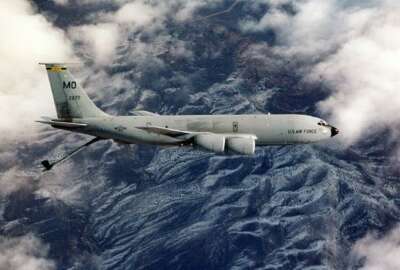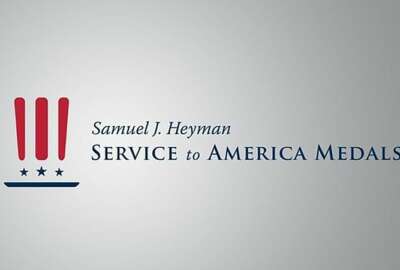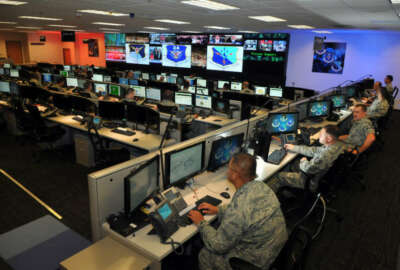
In our Service to America Medals series: How the Air Force went from logjam to innovation factory
The Air Force was among the earliest agencies to organize around the need for innovation. Its approach, known as AFWERX, got started back in 2017 and became a model...
The Air Force was among the earliest agencies to organize around the need for innovation. Its approach, known as AFWERX, got started back in 2017 and became a model for many other agencies. The idea man behind AFWERX is now a finalist in this year’s Service to America Medals program. He’s the first of a series of finalists Federal Drive with Tom Temin will be talking to through October. He’s Mark Ingram, the Chief Strategy Officer of the Air Force Integrated Capabilities Directorate.
Interview Transcript:
Tom Temin And tell us what AFWERX was all about. What was your conception of it way back in 2017 before all these “WERX” got established?
Mark Ingram Well, AFWERX was really looking at how the Air Force can do business differently and how we could empower our workforce, what we call airmen and guardians. And while airmen at the time, guardians now that we’ve got the Space Force, but how we could empower them to look at the problems that they faced on their day to day basis, how could they solve them, scale their solutions and make their lives easier? And really, what started as what we thought was going to be a process oriented discussion of how do we get people to come in and work with us really turned into a cultural movement where it became so much more than just about a process. It’s not just about making acquisition easier, but it’s about finding those ways to get companies to come in and understand what the military needs, helping the military communicate outward because it’s a totally different language. But it’s also about creating that sense of like psychological safety, where our employees felt that they were comfortable and safe to speak up and say, I have a problem, but I think I have a solution as well. And it was about creating an ecosystem. And all of those things together helped us really build out AFWERX into what it is today.
Tom Temin And what were the signals for what was needed that could not be delivered by the standard requirements contracting acquisition system? That sometimes just seems slow.
Mark Ingram When you look at it. I mean, the demand signals from all over the place. I mean, you looked at the traditional Air Force acquisition systems and what we saw was they always went to a handful of big companies, not always, but oftentimes they went to a handful of large companies. And we also saw if you compared what the federal government does in general typically versus what Silicon Valley does, are we getting the best and brightest? And then you look at that from a military lens and say, what are our adversaries doing? What are other countries doing, and are we on track? Are we keeping pace? Are we ahead of them? And what we needed to do is we needed to make sure we were getting the best of all of that. And we were working with the best companies in putting the best idea makers together to deliver real capabilities that our airmen wanted to use and could use.
Tom Temin And what were a couple of the early projects.
Mark Ingram A couple of the early ones, fighter helmets, for example. Fighter helmets, the very old 1980s design incremental changes, just incrementally and new modification would be added, but arguably still the same design. And what AFWERX really did is we looked across the commercial sector, we looked across best practices and said, how do we get new ideas in? And we leveraged crowdsourcing. And so we looked out there and typically you don’t see the federal government asking people to do crowdsourcing to come up with solutions for technology. And so when we did that, we did that on the front end. But on the back end, we also worked the process side. We had the conversations with the acquisition community, the contract, the finance to say how do we actually, if we do this crowdsourcing, how do we get to the next step? How do we scale this? Because we don’t just want it an innovation pocket. We want to be able to scale it and make a difference. That’s one project that one has actually continued forward and we saw great things come out of it. We saw collaboration amongst companies, new helmet designs, which are more ergonomic, better sound protection. Those have come up and they’re actually in testing right now with potential options for fielding within, I think, the next year or two. So that was one of the very early ones. Other projects that we’ve looked at have been related to like female bladder relief, looking at –
Tom Temin In fact, I think I had that interview on the show a number of years ago that that was a real issue as more women came into the flying part of the force.
Mark Ingram That’s right. And that was a problem that came up from the field where we had these female aviators come to us and say what it turned out is oftentimes they were self electing to dehydrate themselves because the solutions that were in place at the time weren’t adequate or didn’t meet their needs or wasn’t comfortable or wasn’t appropriate for them to use.
Tom Temin And that could be dangerous flying at that altitude in a dehydrated situation, especially with the G-forces of fighters.
Mark Ingram Absolutely. And so similar approach, I mean, we took a design thinking approach with some of these major challenges, and we looked and said, what is the root cause of the problem? What’s the solution? How do we think with a user centric mindset to actually develop a reasonable, workable solution? And that’s another one that we’ve looked at. So much about this was empowering people from all levels to make a difference. We had developed what we called our Spark Tank competition, which is kind of like a Shark Tank. If you see the TV show, kind of like a Shark Tank competition. They came in and they pitched their ideas, and one of those ideas was for a new couch for an instructor to lay while they’re training the boom operators who fly in the aerial refueling planes. And so what had been happening is about $100 million a year in medical costs because of back and neck strain, because there wasn’t a platform in place. That simple idea that came from the field, we took that and we worked with that airman and we connected them with potential solutions, small, minimum viable prototypes. Looked at the testing and then started to scale them. And that’s actually been implemented and started to be implemented across an entire fleet of aircraft, saving hundreds of millions of dollars.
Tom Temin We’re speaking with Mark Ingram. He’s chief strategy officer for the Air Force’s Integrated Capabilities Directorate and a finalist in this year’s Service to America Medals Program. And let’s back up a minute. The idea of a separate think tank type of operation within the Air Force. How did that idea get generated and how did it get approved?
Mark Ingram The idea got generated looking across the public sector, looking across best practices of doing basic market research to simplify it is looking back and saying, what has the Department of Defense done when it came to innovation in the past? And you could look at examples like Battle labs and things like that which have come and had some success, had some not so great success. Lessons learned you could pick up. We also looked at what the Air Force was currently doing at the time to say AFWERX wasn’t developed because there was no innovation happening in the Air Force. AFWERX was developed because those pockets of innovation were exactly that. They were pockets. They weren’t at a service level. They didn’t have the level of impact that they could have potentially had by scaling them to a department level. And so what we really looked at as we looked at all of those pockets of innovation, we looked at them almost a mapping of what are different things doing and not doing, Why are these things succeeding in some areas and not other areas? And we developed a concept and that concept was developed in very short order, probably about three or four months, and we proposed it to the vice chief of staff of the Air Force at the time, General Wilson, and it went up to the Secretary of the Air Force and we got approval to stand it up. And a key aspect of AFWERX was opening physical storefronts where nontraditional companies could meet face to face with the military or government civilians and could talk about their problems, talk about their solutions, interface like that. And we opened the first one within three months of the green light, which to get a government contract, a government facility open that was no small lift. But that was the great thing about AFWERX and it still is the great thing about AFWERX, I mean, AFWERX, it has grown so much and it is scaled, but it’s the coalition of everybody coming together for the greater good, which is exactly what we should be doing. We should be making our lives easier, we should be better stewards of everybody’s money and we should be looking at how can we make it better for ourselves.
Tom Temin And at the time, what was your job and were you civilian by then because you did do a four year stint in the Air Force uniform?
Mark Ingram That’s right. I did do active duty. I was a four year active duty working at the Air Force Research Lab. By the time AFWERX came around, I was civil service. And at that time, when the concept first came around, I was actually working in an office, I’m actually partially back in right now, called the Strategic Development Planning and Experimentation Office. And my job in that capacity in part was developing industry strategies for how the Air Force develops new capabilities. So looking at the the Air Force puts out strategy documents that look out 20, 30 years, how do we get that information to the defense industrial base? So I was developing those strategies at the time, and that’s when I started working with AFWERX. As AFWERX was approved and I stood up, I became a director of acquisition and strategy, really building out those partnerships with the acquisition community to help us scale. I was also essentially the director of Operations managing the programmatic aspect of the program of how do we cost schedule performance of all our different contracts, how do we keep the lights on, essentially. How do we attract the right talent, how do we get in? We were attracting talent from all over the world, not just on the government side, but also consultants and people coming in and wanting to work with us because we were doing business different. So Director of Operations and Deputy Lead of AFWERX for about four years while I was there.
Tom Temin All right, so what do you want to do next?
Mark Ingram So actually right now I went from AFWERX and I went from one Air Force innovation arm to to another one. So if you see AFWERX as kind of the the outward public facing and innovation arm where we’re interfacing with companies and public and doing crowdsourcing, there’s other innovation happening and it’s more strategic, it’s more inward focused. It’s maybe not quite ready for us to share with, hey, this is exactly what we’re doing, we want all your ideas. But there were four different offices or different of these offices that were working different spectrums, and they were working in science and technology very early applied research type things all the way up through experimentation and prototyping where they’re actually developing things to put on airplanes and test them out real time. And so all of these offices were doing different things on different time spectrums. And what I’m currently doing as the chief strategy officer for that office, which is the Integrated Capabilities Directorate. We are aligning those four offices to start to look at how can we align Air Force science and technology with Air Force experimentation and prototyping, make sure that it’s connecting in to Air Force strategic architectures like system architectures. But also, and this is the fourth office, how do we meet urgent warfighter needs that are there on a battlefield today and they can’t do this very simple thing and we need to get them a solution. So by integrating all four of those officers together, we’re one, making more resilience, better tools, better capabilities for our warfighters to use on the battlefield. But it’s also giving us a leg up.
Tom Temin And you sound enthusiastic about both innovation itself and the process for fostering innovation two different things.
Mark Ingram Absolutely, yes.
Copyright © 2025 Federal News Network. All rights reserved. This website is not intended for users located within the European Economic Area.
Tom Temin is host of the Federal Drive and has been providing insight on federal technology and management issues for more than 30 years.
Follow @tteminWFED





